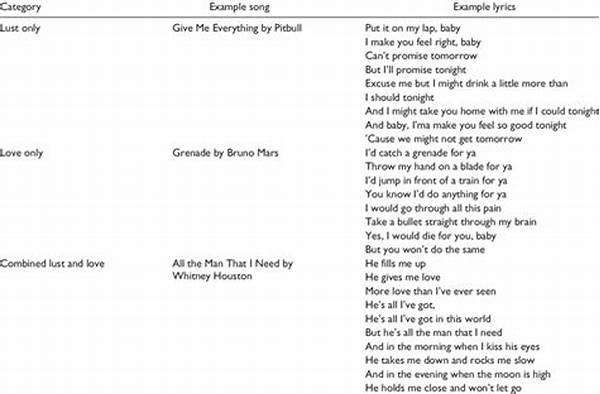The world of music is as dynamic and ever-changing as love itself. Love songs, a staple in the music industry, have evolved dramatically over the decades. From the sweet serenades of the past to the raw, unfiltered jams of today, love song themes reflect the shift in society’s views and experiences with love. In this exploration, we’ll delve into the fascinating evolution of love song themes and examine how they mirror the changing landscape of love and relationships.
Read Now : Heartfelt Melodies From The Past
Evolution of Love Song Themes
Back in the day, love songs were all about flowers, sunsets, and the perfect romance. They painted love as this dreamy, unattainable ideal. Fast forward to today, and we’ve got tracks that are as real as it gets, like straight-up diaries of people’s love lives. These changes in love song themes show how much more open folks are about expressing the highs and lows of love. They’re not just about the “happily ever after” anymore, but also about heartbreak, self-love, and everything in between. It’s like the artists are saying, “Hey, love’s messy, and that’s okay!” So next time you’re jamming to a love track, notice how it captures the rollercoaster of real-life emotions.
Modern Slang in Love Songs
1. Vibes: Today’s love songs often focus on “vibes” rather than old-school romance. These changes in love song themes highlight how connection and understanding are now key.
2. Ghosting: Yup, even ghosting made it to love tracks. These changes in love song themes show how technology’s impact on love can’t be ignored.
3. Ship: We “ship” couples, and that’s a big part of modern love songs. These changes in love song themes embrace online culture and fandoms.
4. Low-key: Love ain’t always grand gestures. Sometimes, it’s low-key and chill. These changes in love song themes embrace simple, everyday love.
5. Bae: Love songs talk about “bae” more than “baby.” These changes in love song themes show a shift to more casual, relatable language.
The Impact of Digital Culture on Love Songs
With the rise of social media and digital communication, love songs have taken on a new dimension. Artists today tap into shared online experiences, creating songs you feel are written right from your group chat. These changes in love song themes illustrate a shift towards inclusivity, embracing the diversity of modern relationships. Someone’s anthem might be about the joy of late-night texting, while another hit track tackles the frustration of being left on “read.” It’s like musicians are speaking the language of today’s digital-savvy generation, making love songs more relatable and authentic than ever. The digital age has opened the door for more voices and narratives, leading to an explosion of themes that cater to the different kinds of love experienced today.
Read Now : “top R&b Tracks From 90s”
A Dive into Diverse Narratives
Changes in love song themes have also brought more representation into the mix. Artists from various backgrounds now have platforms to share their unique stories, bringing fresh perspectives to the table. These songs often tackle topics like identity, gender, and cultural nuances, adding layers to the traditional love song. Whether it’s a track celebrating LGBTQ+ love or an anthem breaking cultural barriers, these pieces reflect a broader spectrum of the human experience. Such diversity in love song themes ensures that more listeners feel seen and heard, further enriching the musical landscape.
The Emotional Spectrum in Modern Love Music
Today’s love songs explore a full spectrum of emotions, from euphoric first loves to the crushing weight of heartbreak. Such changes in love song themes make the music raw and honest. You might listen to a track that lifts you up with its upbeat rhythm, celebrating new love’s joy, then switch to one that echoes heartbreak’s quiet desperation. It’s like a soundtrack to life’s emotional rollercoaster. These multiple layers of feeling resonate with audiences, making them timeless classics that listeners return to again and again. The ever-shifting themes remind us that love is complex, transformative, and, above all, uniquely personal.
The Cultural Influence of Love Songs
Look at how today’s artists weave cultural elements into their music, showcasing changes in love song themes. Whether it’s through incorporating traditional instruments or telling stories influenced by their heritage, these songs become rich tapestries of sound and story. Such cultural influences diversify the music available, allowing listeners to connect with tracks on a deeper level. It’s not just about love itself but also how different cultures express, celebrate, and navigate it. This multifaceted approach allows for a richer, more inclusive musical landscape.
Summary of Changes in Love Song Themes
Love songs reflect society’s evolution, mirroring shifts in our perceptions of love. No longer confined to fairytale-like idealism, today’s tracks embrace the ups and downs of real relationships. These changes in love song themes cater to diverse experiences, resonating more authentically with listeners. Slang-infused lyrics reveal cultural shifts, while digital-age influences ensure they strike a chord with modern lovers. By incorporating diverse backgrounds and cultural nuances, these songs enrich and diversify the musical narrative. This evolving landscape highlights love’s complexities, making the music more relatable and inclusive. As artists continue to push boundaries and explore new themes, love songs will keep evolving, capturing the hearts of generations to come.
